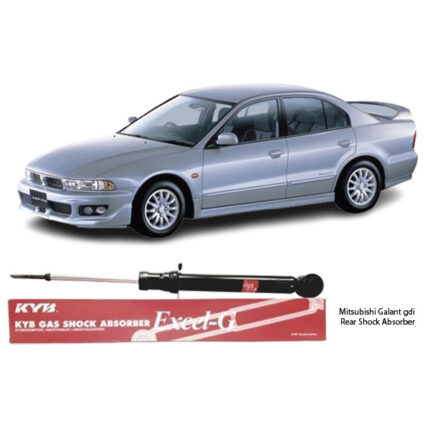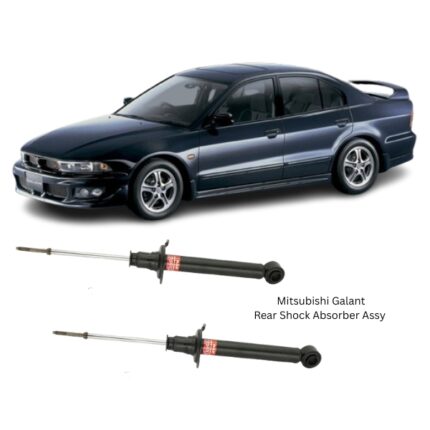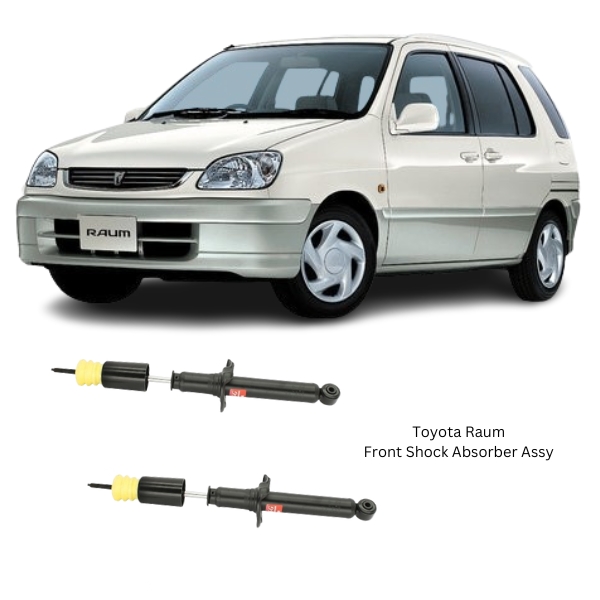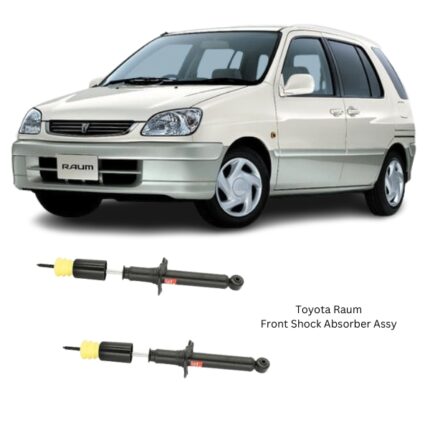Get Toyota Raum Front Shock Absorber Assy 341191 in Kenya
The Front Shock Absorber Assembly is a critical component of a vehicle’s suspension system, designed to control spring and suspension movement. By absorbing and dampening road shocks, vibrations, and oscillations, it ensures the vehicle maintains contact with the road surface, enhancing control, ride comfort, and safety. Positioned on the front suspension, this assembly plays a vital role in managing the dynamic forces acting on the vehicle during acceleration, braking, turning, and navigating uneven terrain.
Constructed with precision engineering and robust materials, the front shock absorber assembly is designed to meet rigorous performance standards under a wide range of operating conditions. Whether navigating urban roads, highways, or off-road terrain, this component ensures that the front wheels respond predictably to driver input and road irregularities.
Function and Purpose
The primary role of the front shock absorber assembly is to:
-
Control Spring Motion: When a vehicle hits a bump or pothole, the suspension springs compress and release energy. The shock absorber regulates this movement to prevent excessive bouncing.
-
Stabilize Steering and Handling: It maintains proper wheel alignment and enhances tire contact with the road for better grip, especially when turning or braking.
-
Improve Ride Comfort: By reducing vibration and harshness transmitted to the chassis and cabin, it ensures a smoother driving experience.
-
Prevent Premature Tire Wear: Dampening excessive vertical motion preserves even tire contact with the road, reducing irregular wear patterns.
-
Reduce Braking Distance: With improved control and road contact, shock absorbers contribute to a more efficient braking response.
Construction and Key Components
A typical front shock absorber assembly is composed of several integrated parts that work in unison to provide damping and structural support:
-
Shock Absorber (Damper)
A hydraulic or gas-charged unit responsible for converting kinetic energy from suspension movement into heat energy, which is then dissipated. -
Piston and Rod
The piston moves up and down within a cylinder filled with hydraulic fluid. Its motion is resisted by valves that control the flow of fluid, creating the damping effect. -
Cylinder (or Tube)
A durable steel or alloy housing that contains the hydraulic oil and internal components. Double-tube or monotube designs are common, each offering specific advantages in terms of cooling, durability, and damping behavior. -
Upper Mounting Plate / Shock Mount
This component secures the top of the shock to the vehicle’s chassis or strut tower. It may contain a bearing assembly for rotational movement (especially in MacPherson strut configurations). -
Lower Mount / Bracket
A strong mounting point at the base of the unit that connects the assembly to the suspension arm or knuckle. -
Dust Boot and Bump Stop
The dust boot protects the piston rod from debris and moisture, while the bump stop prevents the shock from bottoming out under extreme compression. -
Coil Spring Seat (if applicable)
In strut-style assemblies, the coil spring is supported by the shock absorber structure, often seated on a spring perch built into the housing.
Types of Front Shock Absorbers
There are several common configurations used in front shock assemblies, depending on vehicle design:
-
Twin-Tube Hydraulic
Traditional design with an inner and outer tube. It offers a smooth and consistent damping response, ideal for comfort-focused driving. -
Twin-Tube Gas-Charged
Similar to hydraulic shocks but uses nitrogen gas to reduce aeration of the hydraulic fluid, improving response and fade resistance. -
Monotube Design
Features a single, larger cylinder that houses both the damping piston and a high-pressure gas chamber. Known for quick response, better heat dissipation, and higher performance under load. -
MacPherson Strut Assembly
Combines the shock absorber, coil spring, and mount into a single structural unit. It supports both suspension damping and wheel alignment.
Each type is engineered to serve specific ride characteristics, from soft and plush comfort to firm and responsive control.
Performance Characteristics
High-quality front shock absorber assemblies offer several key benefits that improve vehicle dynamics:
-
Controlled Rebound and Compression
Advanced valving systems regulate the speed at which the suspension expands and compresses, maintaining stability during cornering, braking, or acceleration. -
Reduced Body Roll and Dive
By limiting excessive weight transfer, shock absorbers reduce nose-diving during braking and body roll during turns. -
Temperature Resistance
Superior internal components and fluid blends resist thermal breakdown, ensuring consistent performance in hot or cold environments. -
Quiet Operation
Well-sealed units and vibration-reducing mounts minimize clunking, rattling, or squeaking during operation. -
Enhanced Road Feedback
Provides the driver with more predictable and linear steering input and response.
Installation and Maintenance Considerations
Installing a front shock absorber assembly involves removing the wheel, disconnecting the old unit from the suspension and chassis, and bolting in the new component. In strut assemblies, additional care must be taken to safely compress and reinstall coil springs.
Best practices include:
-
Always Replace in Pairs
To maintain balanced handling and consistent ride quality, both left and right front shocks should be replaced simultaneously. -
Check Suspension Hardware
Inspect control arms, bushings, and ball joints for wear. Worn parts can compromise the effectiveness of the new shocks. -
Alignment Check
After installation, it’s crucial to check and adjust wheel alignment to prevent uneven tire wear and ensure straight tracking. -
Observe Torque Specifications
Use manufacturer-recommended torque settings for all mounting bolts to avoid loosening or overtightening.
When to Replace Front Shock Absorbers
While shock absorbers are built for durability, they wear over time. Symptoms of worn or failing front shocks include:
-
Excessive Bouncing
The vehicle continues to oscillate after hitting bumps. -
Nose-Diving During Braking
The front end dips more than usual when stopping. -
Poor Steering Response or Pulling
Difficulty maintaining a straight path or handling turns predictably. -
Uneven or Rapid Tire Wear
Indicating poor road contact or misalignment due to suspension instability. -
Visible Oil Leaks
Fluid seeping from the shock body suggests internal seal failure. -
Clunking Noises
Especially over rough roads, indicating loose or worn internal components.
Routine inspections every 30,000 to 50,000 kilometers are recommended, with replacement generally needed around 70,000 to 100,000 kilometers depending on use.
Durability and Design Standards
The front shock absorber assembly is constructed to withstand high-impact forces, corrosion, and prolonged heat exposure. Key durability features include:
-
Corrosion-Resistant Coatings
Zinc or powder-coated finishes protect against rust from road salt and moisture. -
High-Quality Seals
Keep hydraulic fluid in and contaminants out, preserving internal component life. -
Reinforced Mounts and Bushings
Reduce wear at attachment points and absorb road vibration. -
OEM-Level Precision
Dimensional accuracy ensures direct fitment and correct suspension geometry.
Follow us on Facebook for more parts.




